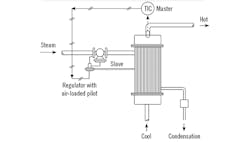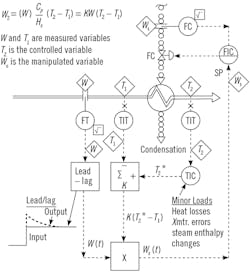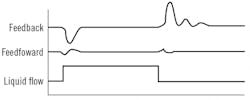To cascade or not to cascade?
This column is moderated by Béla Lipták, automation and safety consultant and editor of the Instrument and Automation Engineers' Handbook (IAEH). If you have an automation-related question for this column, write to [email protected].
Q: I've been reading articles in Control magazine and at ControlGlobal.com for awhile now and they've been very helpful. I was wondering if your team will respond to the following technical question:
Do set criteria exist for determining whether to break regulatory cascades when choosing manipulated variables for advanced process control? For example, manipulating steam flow setpoint instead of the temperature controller setpoint, whose output normally writes to the steam flow setpoint. I’m thinking that if a temperature control (TC) loop (or other master loop) has a time constant greater than 10 minutes, could a one-minute model predictive control (MPC) controller optimize better with the faster slave loop than with the slower master loop? I've run across this issue recently, and I'm not sure of all the considerations that should be considered. Thank you in advance for the response!
Aaron Desmond
[email protected]
Figure 2: Steam heater controlling the critical temperature of a process fluid flow (W), using feedforward-corrected cascade control.
A1: The main advantage of cascade control is that disturbances that occur in the secondary loop are corrected there, and aren't allowed to upset the primary loop. For example if you take the steam heater shown in Figure 1, the existence of a pressure (secondary) loop prevents the effects of steam pressure changes from upsetting the temperature control (primary) loop because the pressure regulator (secondary) keeps the pressure constant (plus corrects for valve sticking or non-linearity). Naturally, the secondary loop must be much faster (usually 10 times faster), so the primary never sees these disturbances. In the "pneumatic age," I used only the simple and cheap pressure regulator shown in Figure 1, as the secondary loop and the clients were always happy with the result, as long as the secondary was much faster than the primary loop.
Conventional cascade is still a feedback configuration, so it still gets upset by load variations (changes in hot water demand). When that occurs, a temperature error must develop in the primary loop before correction is started. Therefore, in critical heater applications, I spend the money on a feedforward cascade system (Figure 2), which doesn't wait for an error to develop in the process fluid temperature control loop, but takes action as soon as the process load (T2) changes to match it with the steam flow (WS), according to the heat and material balance equation (process model) in the figure.
Figure 3: The upsets caused by load (liquid flow) changes in time are much reduced if feedback control is replaced by feedforward.
Figure 3 illustrates the difference in the response to load changes of a feedback and a feedforward system.
Béla Lipták
[email protected]
A2: Operators often don't understand cascade control. They want to take more direct action, so they break the cascade by putting the primary in Manual and operate the secondary in Auto, or sometimes put both primary and secondary in Manual, and take over the steam flow control valve directly by manipulating the secondary Output. This is understandable but it's a sign that the control has failed.
The most frequent problem is that the conventional temperature-to-steam flow cascade is implemented on a heat exchanger with an inherent transport time delay. The process fluid is almost always routed through the tubes of the shell and tube heat exchanger, often making several passes. The dead time between a temperature change on the fluid entering the exchanger and its exit, where the temperature is measured, may often be measured in minutes. You can't optimally tune a PID controller—cascade or not—for this condition. Often a Smith-Predictor can be configured to remove the deadtime from the control action, but that's a crude solution. The best solution is to build a feed-forward, model-based control loop using a first-principles model derived from heat and material balances.
The rationale is to control the flow of steam needed to raise the fluid temperature when it's needed, not just wait for it to be out of control due to the time lag of the heat exchanger. Hopefully, if this cascade is done correctly, the operator will no longer feel the need to break the cascade.
Dick Caro,
ISA Life Fellow
CEO, CMC Associates, [email protected]
A3: The question you raise is a good one, and it doesn't always get the attention it deserves. The regulatory control strategy can have a significant effect on the overall performance of the MPC. A common decision is whether to keep or incorporate a cascade such as a TC to FC. Due to the faster execution in the DCS or PLC (often one second or less), a cascade will normally provide better disturbance rejection capability than the MPC. It will also allow a greater turndown ratio of the MPC, allowing reliable MPC control over a wider range of throughputs. A TC cascade is normally retained on heaters, reactors and distillation columns, or added if one is not in place. For distillation columns, a TC will normally be used if a temperature control point can be found that correlates well with a composition controlled variable (CV) in the MPC. Manipulation of dual-ended temperature controls would be avoided with MPC, with only one temperature controller selected as an manipulated variable (MV) for the MPC. The exception to using a TC can be if the flow controller is a better MV for controlling against a frequently encountered constraint.
Additional information on this topic can be found in the MPC chapter of the Process/Industrial Instruments and Controls Handbook, 6th Edition, edited by Gregory K. McMillan and P. Hunter Vegas.
I normally don’t find that the MPC can control the temperature more tightly due in part to the slower execution period of the MPC. Executing the MPC faster can help, but the MPC will still be controlling multiple control variables simultaneously, which can make MPC tuning more challenging. Note that tuning is normally required of the TC to get proper setpoint and disturbance response.
Some argue for MPC manipulating the FC instead of the TC to get the advantage of decoupling. In my experience, keeping the TC still wins. Decoupling doesn't perform well with high purity columns. Also, the simpler structure of the control matrix with a TC for distillation composition control will be robust for modeling errors and allow a greater throughput turndown ratio.
The main reason for considering manipulation of the FC is constraints, namely if the constraint variable is primarily a function of the flow, rather than the TC. An argument for manipulating flow might be if there are multiple, significant disturbance variables that the TC has trouble rejecting, but these could also be feedforward variables in the regulatory control system.
Mark Darby
[email protected]



